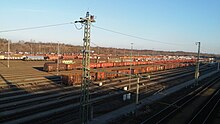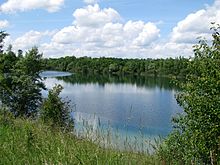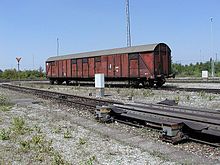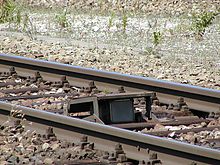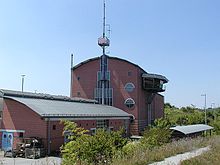Munich north marshalling yard
| Munich north marshalling yard | |
|---|---|
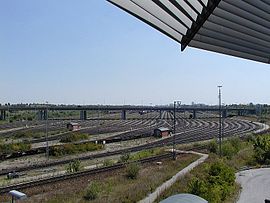 View of the direction tracks
|
|
| Data | |
| Design | Through station |
| abbreviation | MN |
| opening | 1991 |
| location | |
| City / municipality | Munich |
| country | Bavaria |
| Country | Germany |
| Coordinates | 48 ° 11 '41 " N , 11 ° 30' 4" E |
| Railway lines | |
| Railway stations in Bavaria | |
München Nord marshalling yard is a marshalling yard in the north of Munich (in the districts of Moosach and Feldmoching-Hasenbergl ). It was put into operation in 1991 and is one of the most modern marshalling yards in Germany . It replaced the previously used marshalling yards München Ost Rbf and München-Laim Rbf .
construction
The station was planned for 64 direction tracks, divided into eight groups with eight tracks each. In the first construction phase, however, only the five southern track groups with a total of 40 directional tracks were built. No further tracks have been added to this day. Trains can exit directly from the southern direction group; trains from the other four groups must first be brought into the exit group .
Bar rail brakes were installed as hill and valley brakes , rubber brakes are located in the directional tracks. Directly behind this is the clearing zone from which the trolleys are pushed with small trolleys .
As part of the construction work, the Munich – Landshut railway line , which crosses the marshalling yard in the area of the exit group, had to be turned into a tunnel.
The Munich-Ludwigsfeld station south of the construction site was built in the 1940s as a construction goods station for the high-performance marshalling yard planned at the time in the north of Munich. From 1987 it served as a building goods yard for the newly designed marshalling yard in Munich North. Parts of the station were demolished to clear the construction site and the building goods station was completely shut down when the marshalling yard opened in autumn 1991.
criticism
The construction met with fierce resistance from residents and nature conservationists. The action group “Save the North of Munich” represented up to 100,000 citizens in the affected districts from Lerchenau to Allacher Forst. The facility was driven like a safety bolt between the Moosach and Ludwigsfeld districts that belong together. The Lord Mayor Georg Kronawitter castigated the building as a "deadly sin of the century".
environment
The several hundred hectares of the marshalling yard area, which was deported in the 1930s, was left to nature for 50 years. Until construction began in 1988, the site in the middle of Munich was a unique natural paradise with extremely interesting and species-rich types of vegetation, including sea buckthorn thickets , secondary birch forest , pools rich in amphibians and dragonflies, and meadows rich in flowers and insects . Until the destruction in 1988 there should u. a. the largest colony of (now endangered) toad have been in Germany. 174 hectares of biotope area were destroyed. During the construction of the facility, extensive noise barriers and hiking trails were created along the train station. The Allacher Lohe landscape lake was also artificially created. It serves as an operating and extinguishing water lake. Conservationists criticized the fact that the marshalling yard was built directly on the southern border of the Allacher Forest .
business
Working method
In the drive-in group , the wagon groups of the individual trains are separated from each other and not made long , as is the case at many marshalling yards . Specially converted class 290 locomotives serve as mountain locomotives . The train driver only has to steer manually to the end of the train. A computer in the electronic interlocking controls the push-off process . The computer regulates the speed using the digital cutting list for the train. When the cars reach the apex, they run automatically.
A fully automatic operating procedure for the mountain locomotives was tested as early as 1999/2000, but it was not used in real operation due to problems with the radar sensors supplied by Honeywell and finally for further development work that was not available. However, full automation is still planned.
The distribution of the wagons in the individual direction tracks is also done fully automatically. With the help of radar contacts, weight sensors and track contacts, the process control computer in the ESTW calculates the intension of the track brakes. The Beidrück conveyor system is located in the direction tracks , which pushes the individual wagons together so that they can be coupled again for a new train by the shunting staff.
Since the station does not have a re-sorting group (was planned, but has not yet been implemented), the re-sorting work necessary for some connections has to be carried out in the directional groups, which leads to a reduced efficiency of the station.
Train traffic
In addition to the Nuremberg marshalling yard , freight wagons for southern Bavaria are handled in Munich North Rbf. Many trains go to Austria or Italy. In Nachtsprung the station reach freight trains from the German seaports . For the exchange of goods in combined cargo traffic , the Munich-Riem transshipment station is located in the east of Munich . Freight trains to Seddin near Berlin or Halle (Saale) Gbf are mostly handled via Nuremberg. There are therefore special trains several times a day between the marshalling yards in Munich North and Nuremberg.
The cargo service trips are compiled for the Munich area.
Through trains on the Munich North Ring pass the marshalling yard, for example the Rollende Landstrasse .
Signal box
The station is controlled by an electronic signal box, in which not only the dispatchers but also the miners are located. This interlocking is one of the first series interlockings in Germany.
Depot
Attached to the marshalling yard is a depot , in which there are treatment facilities for the locomotives. The depot was controlled by its own small interlocking, which was connected to the dispatcher interlocking in 2015.
Wagon factory
There is also a wagon factory in the station for the maintenance of freight wagons that have to be refurbished due to defects or maintenance deadlines, and the factory also has a track for deadline work and minor repairs on diesel and electric traction vehicles.
Possible closure
In recent years there has been significantly less use of the tracks. Fewer and fewer companies are using existing sidings in Munich. Transporting goods by road is often cheaper. According to information from the rail union EVG, the DB board is specifically examining whether to close the marshalling yard and move it to Nuremberg. The route is also being discussed as a passenger transport S-Bahn-Nordring , as a tangential connection between Moosach and the student city .
See also
literature
- Peter Lisson (ed.): Hub of the South. Munich railway junction . Hestra-Verlag, Darmstadt 1991, ISBN 3-7771-0236-9 .
- Munich North marshalling yard . Shunting technology and track connection technology ( special issue ), episode 51-1991, Darmstadt 1991, ISSN 0342-8753 .
- Railway Atlas Germany - Edition 2005/2006. Vlg. Schweers + Wall, o. O. 2005, ISBN 3-89494-134-0 .
- DB video hub Munich North , 1991.
- Volker D. Laturell : Feldmoching ; Publishing house Dr. Benno Tins, Munich 1970; therein: The marshalling yard Munich-North , pp. 190–195 / history 1938–1966.
Web links
- Track plan Munich North Rbf on the website of Deutsche Bahn (PDF; 1.18 MB)
- Munich North Rbf at openrailwaymap.org
- List of species of the Northern marshalling yard
Individual evidence
- ↑ http://www.eisenbahn-tunnelportale.de/lb/inhalt/tunnelportale/5500.html
- ↑ Photo documentation and history of the Ludwigsfeld train station on doku-des-alltags.de, accessed on October 2, 2016.
- ↑ a b http://www.tz.de/muenchen/stadt/allach-untermenzing-ort43355/macht-bahn-rangierbahnhof-dicht-476393.html
- ↑ http://www.tagschmetterlinge.de/html/naturraum/inn-isar-schotterplatten/muenchen-stadt/rangierbhf_nord.htm
- ↑ Allacher Forst on the online travel guide www.uwefreund.com ( page no longer available , search in web archives ) Info: The link was automatically marked as defective. Please check the link according to the instructions and then remove this notice.
- ↑ The train has left. In: sueddeutsche.de. August 27, 2015, accessed June 13, 2018 .
- ↑ http://www.tz.de/muenchen/stadt/schwabing-freimann-ort43408/s-bahn-haltestelle-knorrstrasse-endung-bahnhof-3549751.html
- ↑ http://www.tz.de/muenchen/stadt/s-bahn-ueber-nordring-wuerde-strecke-vorgangen-tz-6126599.html
